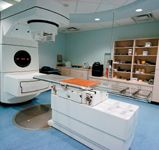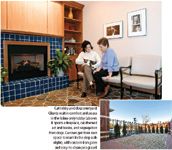Michigan Veterinary Specialists in Southfield, Mich.
Dr. Dan Lorimer, DACVO, wanted his specialty practice to look professional. For that, he needed respectable neighbors. To attract those neighbors, he bought six acres and built a 40,000-square-foot building-which was not his hospital.
Dr. Dan Lorimer, DACVO, wanted his specialty practice to look professional. For that, he needed respectable neighbors. To attract those neighbors, he bought six acres and built a 40,000-square-foot building—which was not his hospital. He leases the building to a bank, an architect group, and a human-medicine specialty group. And, oh yeah, next to that attractive office building, he constructed his own 38,380-square-foot specialty hospital, offering services in ophthalmology, internal medicine, cardiology, neurology, dermatology, oncology, and surgery. He and his four partners have achieved the look they wanted with a facility that earned them a Veterinary Economics 2008 Hospital Design Competition Merit Award.

Blue room: Dr. Dan Lorimer's architect made the break area special with soothing blue colors and flowing curves. "People work hard here," Dr. Lorimer says. "We wanted to make sure they were comfortable." (PHOTOS BY NATHANIEL LAM)
Building again
The new Michigan Veterinary Specialists—with its professional-looking office-building neighbor—is the sixth hospital Dr. Lorimer has built or heavily renovated during his career. The previous location, a 6,500-square-foot conversion of an office building, won him a Merit Award back in 1994. When he needed more space, he bought the 13,000-square-foot building next door and ran a hallway between the two. He didn't make his latest move because he ran of out of room. Rather, "the flow wasn't as organized as it could be," Dr. Lorimer says. "Plus, we ran out of parking."

FLOOR PLAN: Michigan Veterinary Specialists (PHOTOS BY NATHANIEL LAM)
This newest hospital, a project built from the ground up, called on all of Dr. Lorimer's past experience. Before tackling it, he built a 10,000-square-foot satellite clinic in the nearby underserved town of Auburn Hills, Mich. It was a trial run with his builder and architects—Ron Jona and Alex Munoz, who handled interiors—and things worked well. He picked a team member from his administration staff to keep an eye on the projects. "You never have enough time to design everything and watch after it while you're running the practice," he says. "I wanted to know I had someone looking out for our best interests."

A look at the numbers: Michigan Veterinary Specialists (PHOTOS BY NATHANIEL LAM)
Change is never easy
In his new building, Dr. Lorimer organized traffic flow by zones: Reception, exam rooms, and diagnostic areas all wrap around the treatment areas and the ICU. Each specialty gets its own treatment area, so technicians, assistants, associates, and owners all work in their specialty zones. They still get together for rounds every day and cross paths in common areas.

Radiation treatment room: Thirty-six-inch-thick concrete walls and a door with 3,800 pounds of lead keep radiation in. Team members watch the linear accelerator's work on video in an adjacent area. The imaging center, with magnetic-resonance, computed-tomography, and radiography machines, is a few feet away. (PHOTOS BY NATHANIEL LAM)
To make sure all of these teams adjusted well to the new facility and new processes, Dr. Lorimer hired a consulting group to discuss the necessity of the change and the feelings everyone would experience as they adjusted to a new place.

(PHOTOS BY NATHANIEL LAM)
But even with all this preparation and after asking every specialty team what they wanted and needed, there were a few inevitable complaints—and adjustments to make as a result. For example, a week after the move, a technician told Dr. Lorimer he hated the new building. Why? Some of the runs had power outlets in the back, so they were difficult to use. Dr. Lorimer arranged to have electrical cords in the front of those runs.
"After that, the technician said everything was great. That was his only issue," Dr. Lorimer says. "It's gratifying to see how efficiently things run now and to help people transition."

(PHOTOS BY NATHANIEL LAM)
Most likely, this won't be Dr. Lorimer's last construction project. If the hospital needs more space, he'll convert the conference room into surgery and diagnostic areas—he made sure pipes and drains were preinstalled just in case. He'll build more conference and administration space and adjoin it to the existing building when that time comes. The construction—and the thrill—never end.